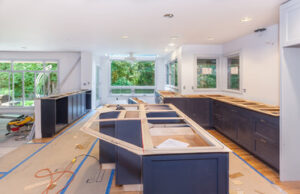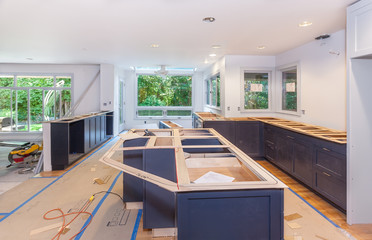How a Designer Can Help With Your Kitchen Remodeling
If you’re a gourmet cook, your kitchen needs to suit your cooking style and accommodate all the tools of the trade. Function is usually the biggest factor, and that’s where a designer can help.
If you’re planning a major renovation, consider working with Kitchen Remodeling Fort Worth who can handle structural changes.
Cabinets are a big part of any kitchen remodeling project. They can determine how functional your space is as well as how much you spend on your kitchen remodel. There are many different styles, colors, and finishes of cabinets to choose from that will complement your kitchen and personality. Cabinet hardware is also important to consider. It is essential to have high-quality hinges in order for your cabinet doors to open and close properly. You can purchase new cabinet hardware or simply replace the old hardware with a more modern style.
A well-executed kitchen remodel can increase the resale value of your home. It can also save you money on your energy bills because it will be more efficient and comfortable. However, it is essential to understand what the best options are when it comes to your budget.
One of the best ways to save on your kitchen remodel is by using a home equity loan. This type of loan uses your home as collateral and offers a fixed interest rate and repayment schedule. It is also a good idea to use an experienced contractor for your kitchen remodel. This will ensure that all of your kitchen remodeling projects are completed on time and within your budget.
There are several types of cabinets, but the most popular are base and wall cabinets. Base cabinets are installed on the floor and help to define your kitchen’s layout. They usually include four kitchen cabinet doors and two functional drawers. Base cabinets are built of solid wood or a combination of materials such as plywood and higher-quality particle board. The hardest, strongest woods are often used for cabinet construction, such as oak and hickory. More durable choices include maple, cherry, and alder. These choices are typically more expensive than oak and hickory, but they hold up better to moisture.
Countertops
Countertops are one of the most important components of a kitchen and can set the tone for the entire room. Today’s trending countertop options range from clean white quartz to industrial-inspired concrete and natural wood. When deciding on the best countertop material for your home, consider several factors: color, overall appearance, durability, stain- and scratch-resistance, price, and maintenance needs.
The most popular choice for homeowners is granite countertops. Known for their elegance, these natural stone surfaces stand out as a focal point and add to a home’s value. However, they can be quite expensive. If you are on a tight budget, consider a plastic laminate countertop. This affordable option is available in a wide range of colors and patterns that mimic the look of stone, marble, and other high-end materials.
Another popular option is tile countertops. Tile comes in a variety of sizes and shapes, including classic squares and trendy hexagons. This countertop material is durable and relatively easy to maintain. Just be sure to use only tiles rated for kitchen use and grout lines that are rated for food contact.
For a more modern, sleek look, try stainless steel counters. Stainless steel is heat-resistant, scratches less easily than other types of countertops, and develops an attractive patina over time. These countertops are a good choice for kitchens that see a lot of cooking and may need to be cleaned frequently.
If you prefer a more traditional aesthetic, try a wood counter. This natural material has a warm, inviting feel that complements many kitchen styles. It is also moisture-resistant, heat-resistant, and scratch-resistant. If you’re worried about maintaining a wooden countertop, you can refresh it with a coat of polyurethane or mineral oil.
Flooring
The kitchen in modern homes is often the center of activity. It is where family and friends gather to enjoy a meal, chat, or catch up on the day’s events. It also expresses the homeowner’s personality and fits into the home’s overall design. The flooring choice must be durable enough to stand up to lots of foot traffic, stains, and spills. The material should complement the color scheme, suit the style of the house, and fit into the remodeling budget.
A popular option is cork tile flooring, which is eco-friendly, durable, and easy to clean. It is also a good alternative for kitchens where there is a lot of cooking and the flooring needs to be water-resistant. Wood floors are a classic choice, but the type of wood must be selected carefully to match the cabinetry. Many homeowners prefer to install their new floors before the cabinets are in place. This allows for a smoother transition from floor to wall and avoids cutting around the cabinet bases.
Kitchen remodels can be major projects that require structural changes, such as dropping walls, rerouting plumbing lines and ductwork, or adding windows and a kitchen island. While some DIYers take on this challenge, it is usually best to have experienced professionals handle this aspect of the job.
When a kitchen is completely remodeled, it may be time to refinish hardwood floors or replace them entirely. Refinishing hardwood floors is a project that can be done relatively inexpensively. It can give the old flooring a new look and can be done at the same time as other renovation work. Alternatively, hardwood floors can be replaced entirely with other materials such as tile or carpet.
Appliances
Appliances are one of the largest line items in any kitchen remodel, so it’s important to pick appliances that fit your lifestyle and style. If you love to entertain, for example, you may want two ovens. Or, if you do most of your cooking in batches for the week ahead, then a refrigerator with a freezer section would be beneficial.
If you’re doing a complete tear-out kitchen remodel, then a stainless steel or black refrigerator can give your new kitchen a cohesive look, and if you’re replacing an existing fridge, then choosing a style that complements the cabinets is key. A microwave is another important appliance to consider, with built-in models and kits becoming popular in new kitchens. Stand-alone countertop units are still common as well.
Microwaves are also a great way to add a pop of color or on-trend design to the space. Many homeowners choose to upgrade from an old microwave that sits on a counter to a hidden version that’s installed in the cabinet.
Upgrading your cabinets, countertops, and flooring is a great way to update the look of a room without spending a lot of money. Other popular and inexpensive upgrades include new lighting fixtures, a second sink or a bar sink, a pantry area, home theater seating, or a basement rec room.
Lighting
When you’re ready to upgrade your kitchen, lighting is one of the first areas to consider. The right lights set a room’s mood, illuminate spaces where you work, and highlight decorative elements like countertops and artwork. It’s important to know the difference between the three basic types of lighting so you can choose a fixture that meets both your functional demands and your design vision.
Lighting options are seemingly endless—pendants, sconces, chandeliers, kitchen lighting under cabinets, and more—and come in a variety of styles and prices. If you’re planning a major kitchen renovation, though, it’s likely that the light fixtures will require professional installation. And since this is a job that involves framing new windows, moving or adding a door, making structural changes to the room, and potentially upgrading your home’s breaker box or adding a subpanel to accommodate new circuits, hiring a contractor for this type of remodel makes a lot of sense.
The best lighting design for a kitchen includes layers of ambient, task, and accent lighting. Ambient lighting is soft overhead light that reflects off the walls and floor to illuminate your space without glare or shadows. This is usually achieved with recessed lighting, which can be controlled with a pre-set dimmer switch or smart home controls.
Task lighting is used to light workspaces like stovetops, counters, and islands where you’re preparing food or working with sharp objects. This is typically accomplished with pendant, under-cabinet, or recessed lights. Lastly, accent lighting is used to highlight decorative items or art on your walls. For this, sconces, wall-mount lamps, and chandeliers are all popular choices. Toe-kick lighting is also often installed in kitchens to light the area under base cabinets.


